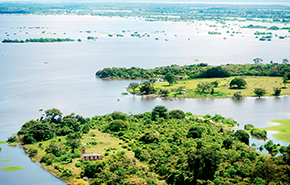
LÉO RAMOSRural Amazon: large properties are cutting down more of the forest than smaller onesLÉO RAMOS
In the area known as the Legal Amazon, large properties are largely responsible for existing levels of deforestation. This was the conclusion of a study conducted by an international group headed by Javier Godar at the Stockholm Environment Institute, in Sweden. The researchers compiled agricultural census and remote sensing data to identify where trees were felled in the Amazon between 2004 and 2011, a period when deforestation rates had declined (PNAS, October 28, 2014). The study included a detailed, close-range analysis of all 13,303 census sectors located in the region, which contains 771 municipalities. Most (55.6%) of the deforestation that took place in the period happened in sectors where properties larger than 500 hectares are prevalent. The areas characterized by smaller properties were responsible for 16.3%. Deforestation rates began to rise again between 2012 and 2013, and researchers stress the importance of understanding this scenario so that better strategies can be defined for the fight against deforestation. The elimination of trees and other vegetation compromises the forest’s ability to store atmospheric carbon and contribute to the water cycle. The study suggests that large agricultural producers may have learned to mislead the inspectors by opening smaller clearings. Possible solutions to address the problem could include a policy based on positive incentives, as exemplified by a number of existing initiatives like the Green Cities Program in the state of Pará. This type of program may also encourage the owners of smaller farms to embrace a more sustainable approach to rural development.
Republish
